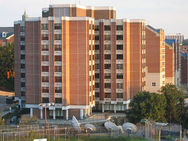OP wants 100% of GU undergrads on campus by 2016

Photo by decaf on Flickr.
Yesterday, the Office of Planning issued its report on Georgetown University’s ten year campus plan. It recommends some severe and surprising restrictions on the university, including a demand that GU house 100% of undergraduates on campus by the fall of 2016.
GU’s proposed campus plan would cap its traditional undergraduate enrollment at 6,652. In addition, it asks to increase its overall cap of undergrads plus graduate students to 15,000. They originally proposed 16,133, but pulled it back in its pre-hearing submission. This would represent an increase of approximately 1,000 students.
OP supports GU growing its overall numbers of students, but with only graduated increases. The reports calls for the total to remain at current numbers for the next two academic years. In 2013 it would rise by about 500; afterwards, if GU meets certain conditions, the total would rise by another 500 or so.
If GU is mildly perturbed about the overall cap conditions, they’re probably livid about the undergrad requirements. OP wants GU to house 100% of traditional undergrad students in GU housing by the fall of 2016. This would also be phased in.
The university previously agreed to build an additional 250 beds on campus by the fall of 2014. On top of that, by the fall of 2015, OP calls for GU to house 90% of its undergrads in GU housing. By the fall of 2016, the requirement is 100%.
If GU doesn’t meet that requirement, OP wants GU’s undergrad cap to be cut annually by 25% of the difference between the cap and the number of beds until it meets the 100% mark.
That additional GU housing also can’t be built east of 37th Street. That’s where the campus gate lies, though the campus boundary is farther east. No housing can be in the 20007 zip code, other than on the campus and behind the gates.
I believe there are about 1,500 GU undergraduates not living in GU housing. That means that after GU adds the 250 that it has already agreed to, it would need to build roughly an additional 1,250 beds by 2016.
GU would have a couple options to satisfy this. First, it could find space for more beds behind the gates. One idea I’ve heard was to build a dorm on top of Leo dining hall, but I don’t know if that is feasible. Second, GU could buy housing for its students outside the 20007 zip code: in other words, in Rosslyn.
All in all, this is a pretty devastating report for GU and I am simply floored by it. But there are still a lot of “ifs.” Most critically, while the Zoning Commission is often deferential to the Office of Planning, there’s no guarantee they’d go along with this severe a proposal. One factor that is definitely not an “if” is the question of what happens if the Zoning Commission adopts OP’s report: years of litigation.
GU appealed the last campus plan decision, and ultimately won. Further, while the courts have rejected various universities’ claims that student caps violate the DC Human Rights Act, the court hemmed and hawed a bit before reaching that conclusion. The court might reach a different conclusion if presented with these more severe conditions.
Either way, this is a huge bombshell in this battle, and it fell squarely on GU.
